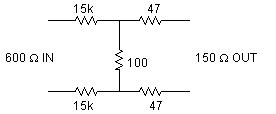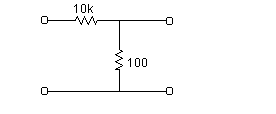Microphone and Line Input: Difference between revisions
No edit summary |
|||
| (7 intermediate revisions by the same user not shown) | |||
| Line 12: | Line 12: | ||
You never want to send a line level signal to the microphone input of an audio device. | You never want to send a line level signal to the microphone input of an audio device. | ||
Consumer rated line level is known as Hi-Z (high impedance) and, as stated above, operate at a -10 DBv level. There are also Hi-Z microphones available that use 1/4" plugs and operate at about -20DBv level. Some guitars and all electric keyboards are also Hi-Z. | |||
Professional devices typically use XLR and are considered balanced. These are Lo-Z and operate at +4 DBm level. There are Lo-Z microphones which will operate at approximately -50 DBm level. | |||
== Microphone Level == | == Microphone Level == | ||
| Line 17: | Line 21: | ||
After the microphone level input goes into an audio device it goes through a preamplifier to boost the signal up to line level. Instrument level input is also very weak, however, may have more variance than that from a microphone. Both will be increased by a preamp prior to mixing or further amplification. | After the microphone level input goes into an audio device it goes through a preamplifier to boost the signal up to line level. Instrument level input is also very weak, however, may have more variance than that from a microphone. Both will be increased by a preamp prior to mixing or further amplification. | ||
When a microphone picks up an acoustic sound wave, it generates a very small voltage waveform which is measured in microvolts. | When a microphone picks up an acoustic sound wave, it generates a very small voltage waveform which is measured in microvolts. | ||
== Conversion == | == Conversion == | ||
| Line 23: | Line 27: | ||
You do not convert a microphone level signal to a line level signal. You simply amplify the microphone level signal with a preamplifier until it is at line level. However, under some circumstances an individual may find the need to feed a line level signal into a microphone level input because the device, such as a radio transmitter, has no other input options. Directly feeding line level into such an input will damage the internal electronics because an already amplified signal level will be fed directly to a preamplifier. If nothing is damaged, the resulting audio will be extremely over-modulated and distorted. | You do not convert a microphone level signal to a line level signal. You simply amplify the microphone level signal with a preamplifier until it is at line level. However, under some circumstances an individual may find the need to feed a line level signal into a microphone level input because the device, such as a radio transmitter, has no other input options. Directly feeding line level into such an input will damage the internal electronics because an already amplified signal level will be fed directly to a preamplifier. If nothing is damaged, the resulting audio will be extremely over-modulated and distorted. | ||
The line level signal needs to be reduced and impedance matched to send it to the microphone input of such a device. This will come with a cost. There will be a reduction in quality and impedance matching may be tricky. | Use a Pad! | ||
The line level signal needs to be reduced and impedance matched to send it to the microphone input of such a device. This will come with a cost. There will be a reduction in quality and impedance matching may be tricky. A great deal of attenuation is needed to match the signal levels. | |||
Consumer audio line (-10dBu) level to microphone matching can be done using a "40 dB L-pad attenuator". Professional audio audio line level (+4dBu) to microphone matching can be done using a "50 dB L-pad attenuator". | |||
L-pad, or simply a "pad" for short, is a simple circuit to accomplish the necessary matching. The pad is typically based on a configuration of resistors to create the necessary amount of attenuation. Pads can be designed to match or ignore impedance. The L-Pad is a type of pad design. | |||
A balanced T-pad (known as an H pad) has resistors in series with both sides of the input, and both sides of the output, but with a common resistor (R2) bridging the midpoints | |||
Radioshack offers an inline pad for an unbalanced, -10dBV source to go into a microphone input. The Radioshack part number is 274-300, the 40dB, RCA-to-1/8" mini-phone, in-line pad. | |||
You can create your own pad using resistors. Here is one example: | |||
[[File:audiolevelmatchingpad.png]] | |||
A simple 2 resistor model can be used. | |||
Attenuation in dB = 20 * log10((R1 + R2) / R2) | |||
[[File:audiolevelmatchingpad2.png]] | |||
The L-pad is the classic voltage divider circuit using two resistors to reduce the input voltage by some amount. | |||
[[Category:Electronics]] | [[Category:Electronics]] | ||
Latest revision as of 21:38, 12 February 2016
In the audio world there are actually four different signal levels that are relevant. The two most discussed in regards to input are line level input and microphone input. First, lets take a look at all four:
- microphone level - weaker audio level than line, such as that from a microphone
- instrument level - weaker audio level than line, such as that from instrument pickups
- line level - used to interconnect audio components
- speaker level - an amplified audio signal for headphones and speakers
Microphone and instrument level audio is weaker than line level. The signal strength can refer to voltage and impedance to produce output power.
Line Level
The line level jacks on consumer electronics are typically unbalanced accepting a TRS Phono Plug. Unlike the weak signal from a microphone, a line level signal is at the highest signal level before final amplification and output to speakers. Consumer line level is rated around -10dBV while there is a different level for professional studio equipment. The most common nominal level for professional equipment is +4 dBu. A line level describes a line's nominal signal level as a ratio, expressed in decibels, against a standard reference voltage.
You never want to send a line level signal to the microphone input of an audio device.
Consumer rated line level is known as Hi-Z (high impedance) and, as stated above, operate at a -10 DBv level. There are also Hi-Z microphones available that use 1/4" plugs and operate at about -20DBv level. Some guitars and all electric keyboards are also Hi-Z.
Professional devices typically use XLR and are considered balanced. These are Lo-Z and operate at +4 DBm level. There are Lo-Z microphones which will operate at approximately -50 DBm level.
Microphone Level
After the microphone level input goes into an audio device it goes through a preamplifier to boost the signal up to line level. Instrument level input is also very weak, however, may have more variance than that from a microphone. Both will be increased by a preamp prior to mixing or further amplification.
When a microphone picks up an acoustic sound wave, it generates a very small voltage waveform which is measured in microvolts.
Conversion
You do not convert a microphone level signal to a line level signal. You simply amplify the microphone level signal with a preamplifier until it is at line level. However, under some circumstances an individual may find the need to feed a line level signal into a microphone level input because the device, such as a radio transmitter, has no other input options. Directly feeding line level into such an input will damage the internal electronics because an already amplified signal level will be fed directly to a preamplifier. If nothing is damaged, the resulting audio will be extremely over-modulated and distorted.
Use a Pad!
The line level signal needs to be reduced and impedance matched to send it to the microphone input of such a device. This will come with a cost. There will be a reduction in quality and impedance matching may be tricky. A great deal of attenuation is needed to match the signal levels.
Consumer audio line (-10dBu) level to microphone matching can be done using a "40 dB L-pad attenuator". Professional audio audio line level (+4dBu) to microphone matching can be done using a "50 dB L-pad attenuator".
L-pad, or simply a "pad" for short, is a simple circuit to accomplish the necessary matching. The pad is typically based on a configuration of resistors to create the necessary amount of attenuation. Pads can be designed to match or ignore impedance. The L-Pad is a type of pad design.
A balanced T-pad (known as an H pad) has resistors in series with both sides of the input, and both sides of the output, but with a common resistor (R2) bridging the midpoints
Radioshack offers an inline pad for an unbalanced, -10dBV source to go into a microphone input. The Radioshack part number is 274-300, the 40dB, RCA-to-1/8" mini-phone, in-line pad.
You can create your own pad using resistors. Here is one example:
A simple 2 resistor model can be used.
Attenuation in dB = 20 * log10((R1 + R2) / R2)
The L-pad is the classic voltage divider circuit using two resistors to reduce the input voltage by some amount.

